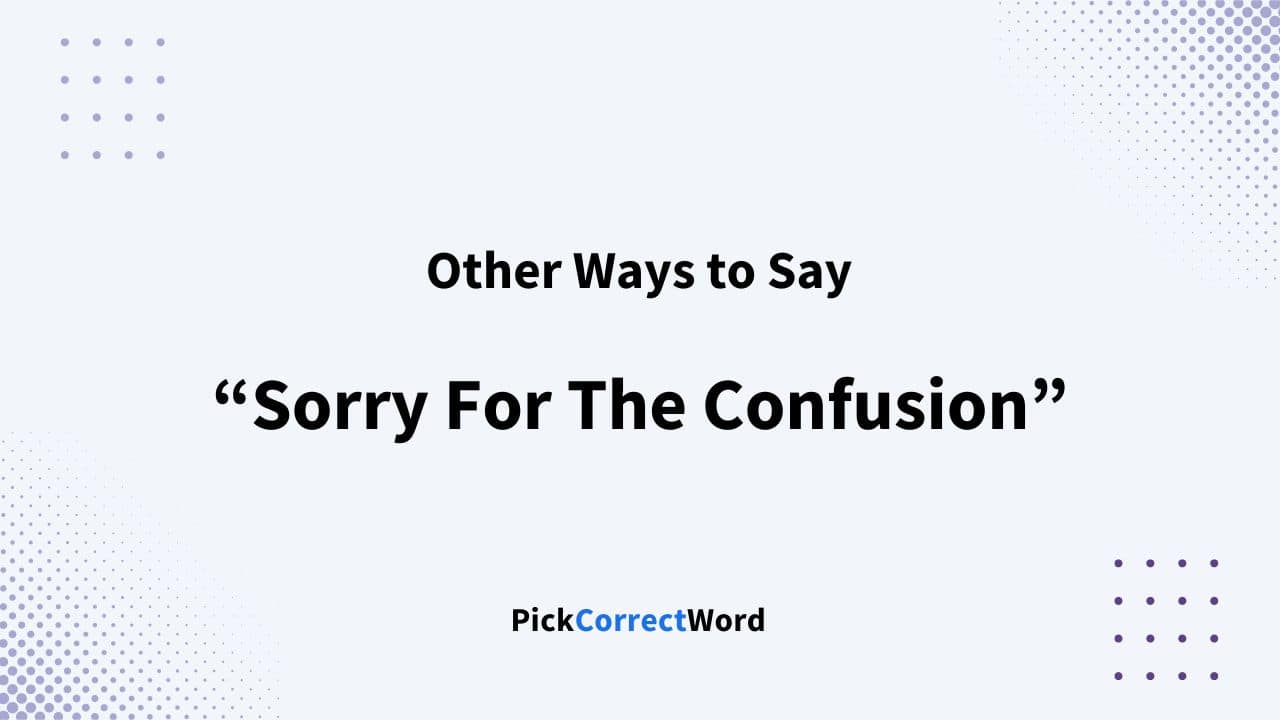Often at work, among friends, or just in day-to-day situations, you might sometimes find yourself in a spot where there’s been a misunderstanding or some sort of mix-up due to your communication.
Saying sorry for the confusion is a courteous way to recognize your error and express regret.
There could be times when you need to convey your regret for causing confusion in a more diverse and subtle way. In these instances, having a variety of alternative phrases ready to use can be really useful.
So, let’s explore our compilation of 12 different ways to say: sorry for the confusion.
Other Ways to Say “Sorry for the Confusion”
- Pardon the confusion
- I apologize for the confusion
- Apologies for the miscommunication
- I regret any misunderstanding
- Pardon any misunderstanding
- Please forgive the confusion
- Apologies for the mix-up
- Sorry if that was confusing
- Sorry about the misunderstanding
- Sorry about this
- I think we’ve misunderstood each other
- My bad
KEY TAKEAWAYS
- “Sorry for the confusion” is a traditional, courteous way to admit a misunderstanding.
- If you want to sound more formal, you can say “I apologize for the confusion” or “pardon any misunderstanding.”
- For a more relaxed tone, phrases like “my bad” or “sorry if that was confusing” keep your apologies friendly and easy-going.
7 Formal Alternatives To “Sorry For The Confusion”
If you’re writing a formal email, dealing with business matters, or trying to keep a professional tone in any written talk, it’s key to deliver your message with the right amount of formality.
Here are seven formal phrases you can use to nicely say sorry and accept blame for any mix-up that’s happened. These will make sure your wish to fix things is understood and respectful.
Pardon the confusion
Starting a conversation with “pardon the confusion” is like extending a formal peace offering, showing that something didn’t come across as you intended.
This phrase is a refined replacement for “sorry for the confusion,” and carries a professional and respectful tone. It’s the kind of language you’d use in a business meeting or a formal letter where you need to keep things proper.
This choice of words and tone can be very effective when you’re speaking to someone higher up, or in a situation that requires a bit more diplomacy.
Sample Email
Dear Mr. Thompson,
This is an update on our next scheduled meeting. Pardon the confusion regarding the meeting date. The correct date is Wednesday, April 5th, not Tuesday. I appreciate your understanding and look forward to our discussion.
Best regards,
I apologize for the confusion
Saying “I apologize for the confusion” is a way to formally and sincerely take responsibility for the situation. This phrase is a straightforward and accountable way to say “sorry for the confusion.”
It shows that you’re not just aware of the mix-up but are also ready to address it. This phrase is your go-to when you want to express a genuine apology and are prepared to work towards a solution.
Feel free to use this in any of your professional communications, like emails or official statements, where being clear and accountable is key.
Sample Email
Dear Dr. Sanchez,
I apologize for any confusion caused by my previous email. The attachment should now be included. Thank you for your patience.
Sincerely,
Apologies for the Miscommunication
When you say “apologies for the miscommunication” you’re highlighting the root of the problem—a break in communication.
These phrases concentrate on the specific issue. Maybe it’s something you just said to the person you’re talking to, which didn’t come out right. Or maybe you wrote an email or a text that could lead to confusion or misunderstanding, and you want to fix it straight away.
Use these phrases when you want to tactfully address the confusion and are keen on stopping similar issues in the future.
Sample Email
Dear Ms. Lee,
Following our conversation about the ongoing negotiations with XYZ Corporation, I have revised the contract terms based on the points we discussed. I’m awaiting your advice on the matter, as we are scheduled to meet with the other party early next week.
Warm regards,
I regret any misunderstanding
Choosing “I regret any misunderstanding” shows that you’re reflecting on the situation with formality and seriousness. It’s a more formal way to say “sorry for the confusion” that highlights your disappointment about the mix-up.
This phrase works well in situations where you need to show deep concern and are committed to making things right. It’s suitable for formal apologies, especially in situations where the confusion might have had big consequences.
Sample Email
Dear Ms. Patel,
I regret any misunderstanding arising from our conversation yesterday. Please find the updated contract attached for your records.
Best,
Pardon any misunderstanding
Using “pardon any misunderstanding” is a way of politely asking that any confusion be overlooked. Use it when you want to quickly move past the mix-up while still acknowledging it.
It’s a handy phrase when dealing with clients or bosses, as it shows your professionalism and desire to keep a good working relationship.
Sample Email
Dear Professor Collins,
It has come to my notice that there has been a slight confusion about the deadlines. Pardon any misunderstanding from my last email. The deadline for submissions remains unchanged. Thank you for your attention.
Regards,
Please forgive the confusion
“Please forgive the confusion” is a way you can admit to a communication slip-up while also politely asking for the other person’s understanding. If you want to show humility and readiness to fix any problems caused by the mix-up, these phrases are your best bet. Use them when you’re looking to make things right and keep the relationship on good terms.
Sample Email
Dear Colleagues,
Please forgive the confusion caused by the scheduling change. Rest assured, all appointments have been rescheduled appropriately.
Kindly,
Apologies for the mix-up
“Apologies for the mix-up” is a formal way to admit that a mistake was made during the exchange of information.
In professional situations where you need to keep a formal tone but also clear up any confusion, saying “apologies for the mix-up” can be a lifesaver. Use these phrases when you want to give a formal apology, clarify the situation, and move forward in a positive way.
Sample Email
Dear Mr. Davidson,
Apologies for the mix-up regarding the documents related to your last order. We will update you with the right documentation shortly.
Best Wishes,
5 Informal Alternatives To “Sorry for the Confusion”
When you’re hanging out with friends, family, or close work buddies, you usually use a relaxed tone. If something gets mixed up, it often feels more natural to use a laid-back tone to sort things out.
Here are five easy-going phrases you can use to say sorry and lighten the mood, without sounding too formal or stiff.
Sorry if that was confusing
When you say “sorry if that was confusing,” you’re admitting things might have gotten a bit mixed up on your side. It’s a relaxed way of saying “sorry for the confusion” without sounding too serious or formal.
Use this phrase when you’re chatting with friends or colleagues in an informal setting and you realize your message didn’t come across as you intended. It’s perfect for those little mix-ups when you want to clear things up quickly without making a fuss.
Sample Email
Hey Sam,
Did you get confused about the plan for the next meet-up at the coffee shop? Sorry if that was confusing. I meant next Friday for our catch-up, not this one. Hope that’s still good for you!
Cheers,
Sorry about the misunderstanding
“Sorry about the misunderstanding” is like extending a peace offering when things get a bit twisted. This phrase is really flexible, fitting nicely into casual conversations, friendly chats, or when you’re fixing plans that went awry. It’s the kind of apology that says, “Let’s figure this out and move on,” without anyone getting stuck on the mistake.
Sample Email
Hi Jenna,
Sorry about the misunderstanding with the report. I’ve sent you the correct version now. Let’s touch base if you have questions.
Best,
Sorry about this
“Sorry about this” is a fast and simple way to admit something went wrong without going into detail. It’s a light-hearted version of “sorry for the confusion.”
You can use this phrase in a group chat, a quick phone call, or when a coffee outing goes a bit off track. It helps you get things back on course with minimal hassle. It’s like a verbal shrug with a smile—no harm done, let’s keep going.
Sample Email
Hey team,
Sorry about this, but can we push our lunch to 1 pm? Got held up with a client call.
Thanks,
I think we’ve misunderstood each other
This is a casual and friendly way to say “sorry for the confusion.” It’s like saying, “We’re in this together.” You’re not just tossing out an apology, you’re inviting the other person to help solve the problem. This phrase works great in many situations, whether you’re coming up with ideas, arguing about the best pizza toppings, or clearing up a misunderstanding with your friend.
Sample Email
Hey Mike,
I think we’ve misunderstood each other about the budget limits for the send-off party next week. Let’s have a quick call to sort it out?
Best,
My bad
“My bad” is a classic, casual way to stay cool when you think you’ve made a mistake. It’s as relaxed as an apology can get. It’s fast, it’s direct, and it has just the right amount of “I messed up, but let’s not dwell on it.” Use it when you want to admit to a mistake without making a big deal out of it.
Sample Email
Yo Alex,
My bad for the wrong info about the game night. It’s actually on the 14th, not tonight. See you there?
Cheers,
In conclusion, there are many ways to say “Sorry for the confusion” that can fit different situations and tones. From a simple “My bad!” to a more formal “I apologize for the confusion,” these phrases can help smooth over misunderstandings and keep communication clear. So next time you find yourself in a mix-up, try one of these 12 phrases that we have listed in this article.


